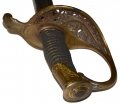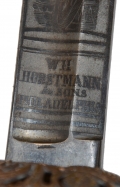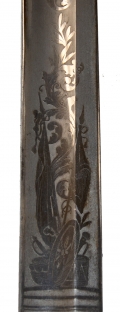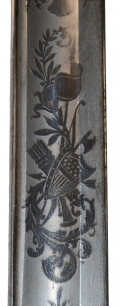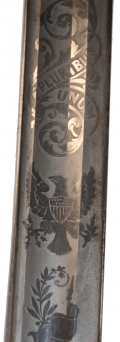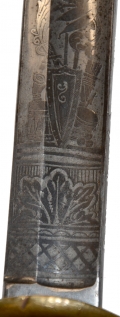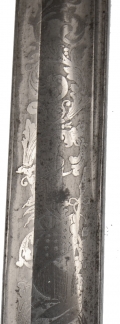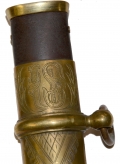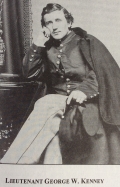site search
online catalog
INSCRIBED HORSTMANN 1850 FOOT OFFICER’S SWORD OF LT. GEORGE KENNEY, LIKELY BAKER’S CALIFORNIA REGIMENT, MORTALLY WOUNDED AT GLENDALE

$3,500.00
Quantity Available: 1
Item Code: 1117-114
This very nice 1850 Foot Officer’s sword by Horstmann has a non-regulation, but very practical metal scabbard and is inscribed inside the guard in script, “Lt. George Kenney.” The volunteer rosters and Heitman’s list of regulars give only three officers of that name, two of whom served only as captains (one in two different Massachusetts units and one in a West Virginia regiment.) We do find the Massachusetts captain later taking a lieutenancy in the 5th U.S. Artillery in 1867, but with the sword coming from Philadelphia, the better candidate seems to be Philadelphian George W. Kenney, who served as Second and First Lieutenant in Baker’s California Regiment, and who was mortally wounded at Glendale on 30 June 1862.
The sword is in excellent condition. The brass hilt follows the regulation pattern with cast and chased leaves and openwork floral scrolls. The brass shows some gilt finish mixed with rubbed areas showing some age-toned brass. The triple wire grip binding in place and tight. The sharkskin wrap shows some minor wear and a seam opening from shrinkage of the grip that is not uncommon and is stable. The red cloth pad is in place on the underside of the guard.
The blade is bright, with good edge and point. The etched frosted panels are strong and the etching vivid. The back of the blade is etched “Iron Proof,” fairly common with German import blades. The obverse is etched at bottom, “W.H. / HORSTMANN / & SONS / PHILADELPHIA,” followed by a trophy of arms, leafy vine and more floral entwined arms. A U.S. eagle with raised wings and “E Pluribus Unum” foliate scroll overhead is centrally positioned, followed by more floral scrolls up to the end of the frosting, which terminates in starburst points. The reverse shows a latticework at bottom, trophy of arms, floral scrolls with a centrally placed U.S., followed by more entwined arms and floral scrolls to the end of the frosting. On both sides the blade is bright above the frosting. The scabbard shows very nice blue to the metal body and gilt brass throat, ring mounts, and drag, the latter of which are engraved on the obverse. The upper mount shows a foliate U.S. above and a chevron with cross-hatched interior and a floral lower border. The latter is repeated on the middle band in both directions, and on the upper portion of the drag with a flower petal, leaves and tendrils below.
Kenney owned at least two swords. A photograph (Lash, p. 59) taken at “Camp Oregon” (occupied by the regiment from 7/27 to 9/4/1861) shows Kenney cradling an 1850 pattern sword foot officer’s sword, but whether the scabbard is leather or metal cannot be made out. It could be this sword or one likely lost at Balls Bluff in October 1861 when he was taken prisoner. Another sword attributed to Kenney, with a French style hilt, is in a California collection and illustrated by Lash (p.236) with the note that its missing scabbard may have been engraved with a presentation from fellow officers for his conduct at Ball’s Bluff. This may be one given by his family either before his capture at Balls Bluff or after his exchange.
Son of a prominent Methodist family in Philadelphia, Kenney was just nineteen years old when he enlisted and was commissioned a second lieutenant in Baker’s California Regiment on 11 July 1861. The regiment had been raised under U.S. government auspices as the brainchild of Oregon Senator Edward Baker with the idea of gaining support and recruits from west coast men resident in the east, but Pennsylvania later took over the regiment as its 71st Infantry. It was organized with a large structure of fifteen companies and Kenney was in one of the later companies recruited in Philadelphia, designated Co. P. This company joined the regiment at Fort Monroe on 18 July 1861, and shortly afterwards the regiment was completed with Company R, spared the embarrassment of being designated with an “O” or “Q.”
Kenney’s youth, diminutive stature, natty dress, and mild manner did not make a good first impression, but his cool conduct in a confused and prolonged night time friendly fire incident at Falls Church in late September was commended. A month later he was in the thick of the fighting at Balls Bluff, an ill-conceived and poorly executed raid-turned-reconnaissance-in-force across the Potomac that resulted in a defeat with 223 Union troops killed, including Senator Baker, then in command of the brigade. Kenney was captured when he remained on the Virginia side of the river with his wounded. He was imprisoned, but exchanged in time to take part in the peninsula campaign the next Spring, and be promoted to First Lieutenant of Company N.
The regiment was lightly engaged at Fair Oaks and saw its heaviest fighting during McClellan’s “change of base” and the Seven Days Battles. On 29 June 1862, as the army pulled back from Fair Oaks, they took part in the fighting at Allen’s Farm losing 96 men and another 68 later in the day at Savage Station. On June 30, below White Oak Swamp, they were heavily engaged at Glendale (aka Nelson’s Farm,) when Confederate troops attacked the Federal column as road system forced it to turn west and then again south. The regiment took part in a charge to restore Union lines and in rallying his men with the cry, “Stand up to it like men!” he was shot through the body and carried to a field hospital in the rear. He died there on July 2 while it was in Confederate hands. His grave was marked, however, and the family subsequently retrieved his body, burying him in the cemetery of the Wharton Street Methodist Episcopal Church, where his father was superintendent of the Sunday School. The pastor, Rev. G.D. Carrow, eulogized him in a religious tract titled, “The Model Soldier. A Memoir of Lieutenant George W. Kenney, of the (First California) Seventy-first Regiment, Pennsylvania Volunteers.” He was subsequently re-interred once again in Bala Cynwyd, Pa., around 1905. [sr]
~~~~~~~~~~~~~~~~~~~~~~~~~
THIS ITEM, AS WITH ALL OTHER ITEMS AVAILABLE ON OUR WEB SITE,
MAY BE PURCHASED THROUGH OUR LAYAWAY PROGRAM.
FOR OUR POLICIES AND TERMS,
CLICK ON ‘CONTACT US’ AT THE TOP OF ANY PAGE ON THE SITE,
THEN ON ‘LAYAWAY POLICY’.
THANK YOU!
Inquire About INSCRIBED HORSTMANN 1850 FOOT OFFICER’S SWORD OF LT. GEORGE KENNEY, LIKELY BAKER’S CALIFORNIA REGIMENT, MORTALLY WOUNDED AT GLENDALE
For inquiries, please email us at [email protected]
Most Popular
Historical Firearms Stolen From The National Civil War Museum In Harrisburg, Pa »
Theft From Gravesite Of Gen. John Reynolds »
Cavalry Carbine Sling Swivel »
Fine Condition Brass Infantry Bugle Insignia »
featured item
OFFICER’S FROCK COAT OF BREVET MAJOR GENERAL JOSEPH K. BARNES, SURGEON GENERAL OF THE U.S. ARMY 1864-1882
This would be the centerpiece of any medical collection: the Major General’s frock coat of Surgeon General Joseph K. Barnes. Barnes was born in Philadelphia in 1817, studied medicine at Harvard, under US Navy Surgeon General Harris, and received… (1179-579). Learn More »








